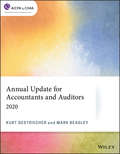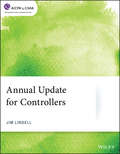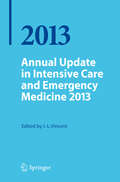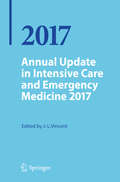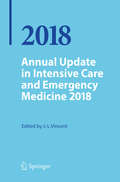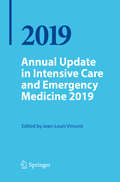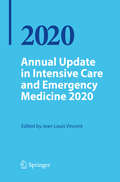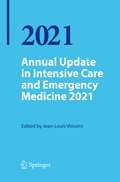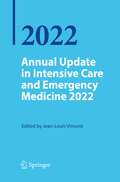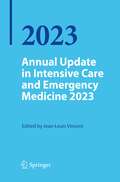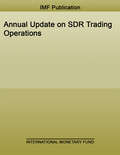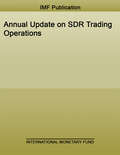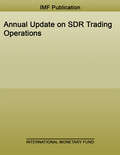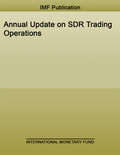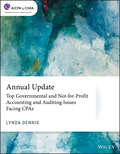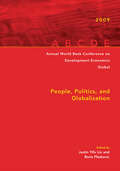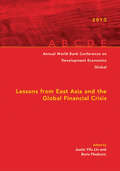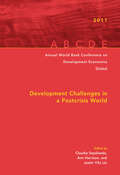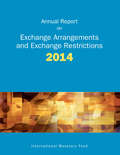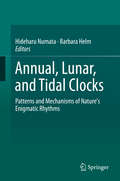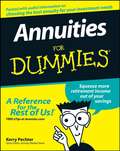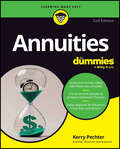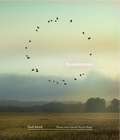- Table View
- List View
Annual Update for Accountants and Auditors: 2020 (AICPA)
by Kurt Oestriecher Mark BeasleyKeep abreast of the fast-paced changes in accounting and auditing with relevant pronouncements, exposure drafts, and other guidance recently issued in the accounting, auditing, compilation, preparation, and review arenas. This book will help accountants and financial managers sort through the most recent accounting and auditing complexities so they can identify and apply recently issued FASB, PCAOB, and AICPA standards and guidance. New topics covered include: Revenue recognition Leases Financial instruments Intangible assets Consolidation Business combinations Recently issued SAS No. 134–140 Auditing interpretations Recently proposed SSAE standards Overview of SSARS guidance
Annual Update for Controllers (AICPA)
by Jim LindellThis guide covers leading-edge topics in managerial accounting and finance. It's packed with useful tips and practical guidance controllers and financial managers can apply immediately. You'll also gain insight into hot topics such as: Power Pivot Integrated Reporting Bitcoin Technology trends In addition, this guide includes a case study covering three chapters using Excel tools, working capital trends and technology changes.
Annual Update in Intensive Care and Emergency Medicine 2016 (Annual Update in Intensive Care and Emergency Medicine)
by Jean-Louis VincentThe Annual Update compiles the most recent developments in experimental and clinical research and practice in one comprehensive reference book. The chapters are written by well recognized experts in the field of intensive care and emergency medicine. It is addressed to everyone involved in internal medicine, anesthesia, surgery, pediatrics, intensive care and emergency medicine.
Annual Update in Intensive Care and Emergency Medicine 2017 (Annual Update in Intensive Care and Emergency Medicine)
by Jean-Louis VincentThe Annual Update compiles reviews of the most recent developments in experimental and clinical intensive care and emergency medicine research and practice in one comprehensive reference book. The chapters are written by well recognized experts in these fields. The book is addressed to everyone involved in internal medicine, anesthesia, surgery, pediatrics, intensive care and emergency medicine.
Annual Update in Intensive Care and Emergency Medicine 2018 (Annual Update in Intensive Care and Emergency Medicine)
by Jean-Louis VincentThe Annual Update compiles reviews of the most recent developments in experimental and clinical intensive care and emergency medicine research and practice in one comprehensive reference book. The chapters are written by well recognized experts in these fields. The book is addressed to everyone involved in internal medicine, anesthesia, surgery, pediatrics, intensive care and emergency medicine.
Annual Update in Intensive Care and Emergency Medicine 2019
by Jean-Louis VincentThe Annual Update compiles reviews of the most recent developments in experimental and clinical intensive care and emergency medicine research and practice in one comprehensive reference book. The chapters are written by well recognized experts in these fields. The book is addressed to everyone involved in internal medicine, anesthesia, surgery, pediatrics, intensive care and emergency medicine.
Annual Update in Intensive Care and Emergency Medicine 2020 (Annual Update in Intensive Care and Emergency Medicine)
by Jean-Louis VincentThe Annual Update compiles reviews of the most recent developments in experimental and clinical intensive care and emergency medicine research and practice in one comprehensive reference book. The chapters are written by well recognized experts in these fields. The book is addressed to everyone involved in internal medicine, anesthesia, surgery, pediatrics, intensive care and emergency medicine.
Annual Update in Intensive Care and Emergency Medicine 2021 (Annual Update in Intensive Care and Emergency Medicine)
by Jean-Louis VincentThe Annual Update compiles reviews of the most recent developments in experimental and clinical intensive care and emergency medicine research and practice in one comprehensive book. The chapters are written by well recognized experts in these fields. The book is addressed to everyone involved in internal medicine, anesthesia, surgery, pediatrics, intensive care and emergency medicine.
Annual Update in Intensive Care and Emergency Medicine 2022 (Annual Update in Intensive Care and Emergency Medicine)
by Jean-Louis VincentThe Annual Update compiles reviews of the most recent developments in clinical intensive care and emergency medicine research and practice in one comprehensive book. The chapters are written by well recognized experts in these fields. The book is addressed to everyone involved in intensive care and emergency medicine, anesthesia, surgery, internal medicine, and pediatrics.
Annual Update in Intensive Care and Emergency Medicine 2023 (Annual Update in Intensive Care and Emergency Medicine)
by Jean-Louis VincentThe Annual Update compiles reviews of the most recent developments in clinical intensive care and emergency medicine research and practice in one comprehensive book. The chapters are written by well recognized experts in these fields. The book is addressed to everyone involved in intensive care and emergency medicine, anesthesia, surgery, internal medicine, and pediatrics.
Annual Update on SDR Trading Operations
by International Monetary Fund. Finance Dept.A report from the International Monetary Fund.
Annual Update on SDR Trading Operations (Policy Papers)
by International Monetary Fund. Finance Dept.A report from the International Monetary Fund.
Annual Update on SDR Trading Operations (Policy Papers)
by International Monetary Fund. Finance Dept.A report from the International Monetary Fund.
Annual Update on SDR Trading Operations (Policy Papers)
by International Monetary Fund. Finance Dept.A report from the International Monetary Fund.
Annual Update: Top Governmental and Not-for-Profit Accounting and Auditing Issues Facing CPAs (AICPA)
by Lynda DennisThis book provides a review of the top accounting and auditing issues faced by preparers of governmental and not-for-profit financial statements and their auditors. Key areas covered include: GASB 87, Leases; revenue recognition, including grants and contracts; risk assessment; and financial reporting. Key topics include: · Current GASB developments · Audit issues related to GASB developments · Recent GASB pronouncements and their impact on accounting and reporting · Top advice from the AICPA&’s Technical Hotline and the GASB Technical Inquiry System
Annual World Bank Conference on Development Economics 2009, Global
by Justin Yifu Lin Boris PleskovicThis annual conference is a global gathering of the world's leading scholars and practitioners. Among the attendees are participants from developing countries, think tanks, NGOs, and international institutions. These papers concern: Trade and economic performance: does Africa's fragmentation matter?; Protectionist Policies and Manufacturing Trade Flows in Africa; Criss-Crossing Globalization: The Phenomenon of Uphill Skills flows; The Aid-Migration Trade off; Are Remittances More Effective than Aid to Improve Child Health? An Empirical Assessment Using Inter- and Intra-country data; Role of Emigration and Emigrant Networks in Labor Market Decision of non-Migrants; the Role of Higher Education in High-tech Industry Development: A Review of International Experience; Higher Education and Industry: What Linkages in Africa; An Arrested Virtuous Circle?; Higher Education and High-tech Industry in India; Health and socio-economic status: Isolating causal pathways; The Household Impacts of Treating HIV/AIDS in Developing Countries; First Things First: Infectious Disease, Child Mortality and the poor in India 1992-2005; What Makes Growth Shared?; On the Political Economy of Inclusive Development; Characterizing Conflict Forms; Public Goods Provision in South Asia. Introduction by Justin Yifu Lin and Boris Pleskovic. Opening addresses by Trevor Manuel, Justin Yifu Lin, and Thabo Mbeki. Keynote addresses by Michael Spence, Bassma Kodmani, and Sunil Kant Munjal. Papers by Paul Collier and Anthony J. Venables; Lawrence Edwards; Aaditya Mattoo and Arvind Subramanian; Jean-Paul Azam and Ruxanda Berlinschi; Lisa Chauvet, Flore Gubert, and Sandrine Mesplé-Somps; Jinu Koola and Çaglar Özden; Sachi Hatakenaka; Akilagpa Sawyerr and Boubakar Barry; Rakesh Basant and Partha Mukhopadhyay; Duncan Thomas; Markus Goldstein, Joshua Graff Zivin, and Harsha Thirumurthy; Francisco Rodríguez; and Lakshmi Iyer. Comments by Beata Smarzynska Javorcik, Melvin D. Ayogu, Jean-Luc Demonsant, Erik Sander, Shahid Yusuf, Pankaj Chandra, T. Paul Schultz, John Strauss, and Ashutosh Varshney. Closing remarks by Alan Gelb and Fundi Tshazibana.
Annual World Bank Conference on Development Economics 2010, Global
by Justin Yifu Lin Boris PleskovicThe Annual World Bank Conference on Development Economics (ABCDE) is one of the world's best-known series of conferences for the presentation and discussion of new knowledge on development. The conference provides a forum for the world's leading development thinkers to share new knowledge and ideas. 'Lessons from East Asia and the Global Financial Crisis' was the theme of the ABCDE held in Seoul, Republic of Korea, on June 22-24, 2009. The conference was co-organized by the Government of the Republic of Korea, the Korea Development Institute (KDI), and the World Bank.
Annual World Bank Conference on Development Economics 2011
by Justin Yifu Lin Claudia Paz SepulvedaThe Annual World Bank Conference on Development Economics 2011: Development Challenges in a Post-crisis World (ABCDE) presents papers from a global gathering of the world's leading development scholars and practitioners held May 31 - June 2, 2010. Paper themes include: Environmental Commons and the Green Economy, Post-crisis Development Strategy, the Political Economy of Fragile States, Measuring Welfare, and Social Programs and Transfers. Keynote addresses: Elinor Ostrom: Overcoming the Samaritan's Dlimemma in Development Aid -- Torsten Persson: Weak States, Strong States, and Development -- Joseph Stiglitz: Learning, Growth, and Development -- Partha Dasgupta: Poverty Traps --
Annual World's Best Science Fiction 1975
by Donald A. WollheimTOP NOTCH RELIABLE AUTHENTIC EXCELLENT BEST OF THE BEST HIGHLY RECOMMENDED These are just a few of the favorable comments made by reviewers about this series in past years. They will be made again for this prime and authentic selection of the superior science fiction stories of the year past. It is a DAW tradition that the "World's Best" is not merely the first of its kind each year but that it holds up as the most solidly certain selection of the finest and most memorable science fiction stories by the writers, old and new, of the highest talent. THE 1975 ANNUAL WORLD'S BEST SF is always what its name implies. A DAW BOOKS ORIGINAL-- NEVER BEFORE IN PAPERBACK
Annual report on exchange arrangements and exchange restrictions, 2014
by International Monetary FundThis is the 65th issue of the AREAER. It provides a description of the foreign exchange arrangements, exchange and trade systems, and capital controls of all IMF member countries. It also provides information on the operation of foreign exchange markets and controls on international trade. It describes controls on capital transactions and measures implemented in the financial sector, including prudential measures. In addition, it reports on exchange measures imposed by member countries for security reasons. A single table provides a snapshot of the exchange and trade systems of all IMF member countries. The Overview describes in detail how the general trend toward foreign exchange liberalization continued during 2013, alongside a strengthening of the financial sector regulatory framework. A Special Topic essay examines the dynamics and evolution of capital flows. The AREAER is available in several formats. The Overview in print and online, and the detailed information for each of the 191 member countries and territories is included on a CD that accompanies the printed Overview and in an online database, AREAER Online. In addition to the information on the exchange and trade system of IMF member countries in 2013, AREAER Online contains historical data published in previous issues of the AREAER. It is searchable by year, country, and category of measure and allows cross country comparisons for time series.
Annual, Lunar, and Tidal Clocks: Patterns and Mechanisms of Nature's Enigmatic Rhythms
by Hideharu Numata Barbara HelmThere is more to biological rhythms than circadian clocks. This book aims at promoting the exciting potential of a deeper understanding of circannual, circatidal, and circalunar clocks. It highlights new developments, summarizes existing knowledge, and integrates different perspectives with the tools and ideas of diverse fields of current biology. For predominantly pragmatic reasons, research in recent decades was mostly concerned with circadian clocks. Clocks on other timescales, however, have been largely neglected and therefore still appear "enigmatic". Thanks to the rapid development of methods in molecular biology as well as in ecology, we are now able to re-approach these clocks. Laboratories around the world are showing fresh interest and substantial progress is being made in many independent projects. The book's two sections address the moon-derived circatidal, circasemilunar, and lunar cycles on the one hand (10 chapters), and the sun-derived circannual cycles on the other (6 chapters). This work brings together authors with an expansive array of expertise and study systems, ranging from tidal cycles of marine invertebrates to annual cycles of birds and mammals, and from behavioral to genetic and epigenetic backgrounds. While great challenges remain to be mastered, the book aims at conveying the excitement of unraveling, broadly, the rhythms of life.
Annuals
by Ted Martson Andrew LawsonArranged like an encylopedia, Annuals discusses the variety, proper care and importance of growing annual plants.
Annuities For Dummies
by Kerry PechterWhy look into annuities? If you're a Baby Boomer with little or no pension and most of your money in low-interest savings accounts, an annuity may be the key to a secure and comfortable retirement. How can you find out whether an annuity is right for you? Read Annuities For Dummies, 3rd Edition.This completely revised and updated, plain-English guide is packed with the latest information on choosing the best annuity for your retirement needs. You'll find out exactly what annuities are, whether they're the right financial vehicle for you, and which of the many annuity options might have your name on it. You'll learn the ins and outs of using annuities to fund your retirement years, figure out whether to stress investments with insurance or insurance with investments, and find out how the right combination of annuities can help you squeeze more income out of your savings that any other financial tool. Discover how to:Identify the main types of annuitiesWeigh the pros and cons of annuities for yourselfMinimize the complexity and cost of your annuity investmentFigure out how much money to commitAvoid common annuity pitfallsCreate an income you can't outliveThe time to start securing your financial future is now. Annuities For Dummies, 3rd Edition, gives you knowledge, insider tips, and expert advice you need to make your money do its best for you.
Annuities For Dummies
by Kerry PechterLooking for steady retirement income? Read this book! Turning retirement savings into a steady income is a big step toward a worry-free retirement. This book introduces you to how to add annuities to your investment mix. It helps you evaluate how to select the best annuities for your needs and steer clear of the worst. You’ll learn how different types of annuities can help you turn your retirement savings into a monthly paycheck, protect your investments from market ups and downs, postpone taxes, stay in your home for the rest of your life, and even buy long-term care insurance for less.. Written by an annuity thought leader who is a frequent guest-expert on webcasts, podcasts and radio broadcasts as well as editor and publisher of Retirement Income Journal, the book offers the knowledge earned from interviews with hundreds of annuity industry insiders on their own turf. Get insight into which annuities do (or don’t) provide near-retirees and retirees with solid value. Stretch your savings into lifelong income Ask smarter questions when talking to an agent, broker or adviser Retire with less anxiety about the market Feel more in control of your financial life Annuities For Dummies is the must-have guide for anyone making retirement plans or managing their retirement savings.
Annulments
by Zach SavichWinner of the 2010 Colorado Prize for Poetry. "It is the poet who, undistracted by the imbecile telegraphy of this moment, dares to sustain a sustaining sound I most esteem and most warmly embrace. Zach Savich has written a book both intimate and vast, both tender and acidly candid. And with his long poem, 'The Mountains Overhead,' he has entered that visionary company of poets who, by overturning Babel, lay the heavens at our feet." --Donald Revell "Sparse, spare, these lines nonetheless overflow with a sheer and brilliant imagination- 'The crows: hearing our voices through wires'; 'the horses hold themselves like torches'; 'the sun a dial tone . . .' The tension between minimalism of form and maximalism of concept and feeling gives this work a vivid, oddly crystalline, momentum. The central long poem unfolds one small leaf at a time, yet resists accumulation; instead it presents us again and again with the opportunity to immerse ourselves in the slightly uncanny: what would it be to sing instead of to say? This book gives us an intimation." --Cole Swensen
